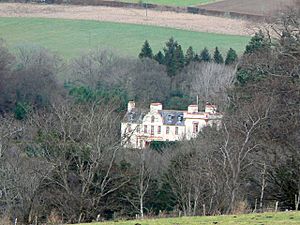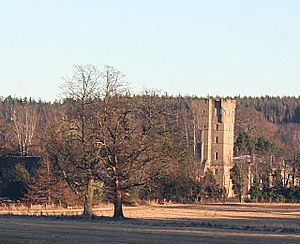James Crichton of Frendraught facts for kids
James Crichton of Frendraught was a Scottish landowner involved in a mysterious fire on 18 October 1630. Eight guests died at Frendraught Castle, and many suspected someone had deliberately set the fire. The true story of what happened was debated for a long time.



Contents
Who Was James Crichton?
James Crichton of Frendraught came from an important Scottish family. His parents were James Crichton and Janet Gordon. After his father died, he became known as the "Laird of Frendraught." This meant he was the owner of the Frendraught estate.
Frendraught Castle, which has been rebuilt, is about 6 miles (10 km) east of Huntly, in Aberdeenshire, Scotland.
In 1619, James Crichton married Elizabeth Gordon. She was the oldest daughter of the Earl of Sutherland. They married at the Castle of Bog of Gight, now called Gordon Castle. In early modern Scotland, married women usually kept their own last names. So, she was known as "Elizabeth Gordon, Lady Frendraught." Their oldest son, also named James, later became Viscount Frendraught.
The Mysterious Fire
In January 1630, James Crichton's followers had a fight with the Gordons of Rothiemay. This fight was over fishing rights on the River Deveron. During the fight, William Gordon of Rothiemay was badly hurt by a gunshot and later died. Another man, George Gordon, also died from his injuries.
Later that year, in October 1630, James Crichton invited several friends and allies of the Gordon family to stay at his tower in Frendraught Castle. He wanted their protection from his enemies. But then, the house caught fire.
The fire killed Lord Aboyne (also known as Viscount of Melgum) and the younger John Gordon, Laird of Rothiemay. Other people also died. They could not escape because the wooden stairs collapsed. The windows had iron bars, making it impossible to jump out. James Crichton and his wife were in another part of the house. They watched the fire from the yard. Many people suspected that James Crichton and his wife had set their own castle on fire.
The day after the fire, Elizabeth Gordon, Lady Frendraught, rode to Gordon Castle. She wanted to tell her side of the story. However, she was not allowed inside.
James Crichton then moved to Gladstone's Land in Edinburgh. He lived there until 1635. This allowed him to talk with lawyers about the fire. His two sons joined him in Edinburgh. His wife, Lady Frendraught, stayed in the north with their daughters. She lived at Kinnairdy Castle on the Deveron.
Seeking Justice
James Crichton asked the Privy Council for justice in November 1630. The Privy Council was a group of advisors to the King. They sent people to investigate the ruins of Frendraught in April 1631. They thought the fire had started in three different places inside the castle.
King Charles I wanted the investigators to question suspects very strictly to get information. But the Privy Council said that only they could decide on such methods in Scotland.
Three of Crichton's servants were accused of murder and setting the fire. They were John Meldrum, John Tosch, and a female servant named Margaret Wood. Other servants were also questioned. Some servants said that the Laird and Lady of Frendraught ran to the barnyard when they heard cries of fire. They thought an outlaw named James Grant was attacking. One servant said that Lord Melgum probably died from the smoke before the fire even reached him.
Margaret Wood's Story
Margaret Wood was questioned harshly. She first pretended to be her sister and made false accusations. She even tried to blame her employer, Lady Frendraught. After her story changed many times, she was found guilty of lying. She was whipped through Edinburgh and sent away from the area.
John Meldrum's Conviction
John Meldrum, a former servant of Frendraught, was also questioned very strictly. He was hanged in August 1633 for starting the fire. People said he held a grudge against the Laird of Frendraught. It was also said that he had stolen horses from Frendraught. Some believed his conviction helped to shift blame away from the ongoing family feuds.
After Meldrum was found guilty, John Toash's lawyer successfully argued that the case against Toash was disproved.
Lady Rothiemay's Actions
Even after Meldrum's execution, the Gordon family continued their feud with the Crichtons. Katherine Forbes, Lady Rothiemay, had lost both her husband and son in the feud. Many believed she encouraged raids against Frendraught in 1634. It was even said she danced with the Highlanders who raided Frendraught's barnyard.
Lady Rothiemay was held in Edinburgh for a while. She was released in 1637 after King Charles I gave instructions for her freedom.
Stories and Legends
Many people wrote about the Frendraught fire. Some writers in the 1700s used the event to show how fierce Scottish clans could be. They also used it to point out problems with old laws in Scotland.
Some stories said that the Laird of Frendraught had set the fire himself. They claimed Meldrum was an innocent person who was blamed instead.
A historian named John Spalding wrote an important description of the fire in the 1600s. This account was published in 1792 and greatly influenced how people understood the event.
In the 1800s, a collector of old stories, Charles Kirkpatrick Sharpe, heard a legend. This story said that Lady Frendraught had made a deal with the devil. It claimed she watched the tower burn, laughing and clapping. She appeared much taller than usual in the light of the flames. Another story said the missing keys to the tower were found in a well when Frendraught House was rebuilt.
Even though he loved these legends, Charles Kirkpatrick Sharpe believed that James Crichton and Lady Frendraught were innocent. He thought they did not set their own house on fire.
Objects from the Past
In 1633, James Crichton gave a silver communion cup to the church at Forgue. He might have done this to mark what he hoped was the end of his troubles. The cup was made in 1563 by an Edinburgh goldsmith named James Cok. Crichton also gave silverware to other churches.
Portraits believed to be of James Crichton and Lady Frendraught were kept at Montblairy in Banffshire. These paintings show James Crichton at age 36 in 1634 and Lady Frendraught at age 34 in 1637.
|


